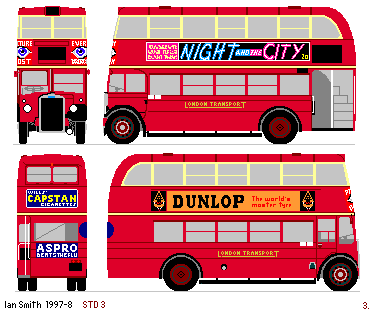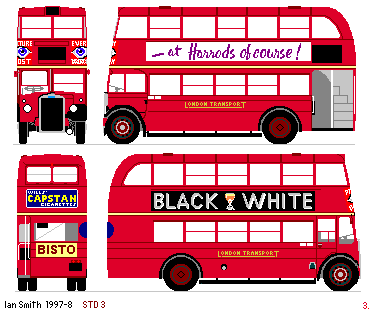
The LONDON TRANSPORT STDsThis page created December 1997 by Ian Smith, updated 14th October 1999ContentsThere were three distinct groups of STDs:
The Post-War STDs STD 112-176 (Total 65) Introduced: 1946. This time the Leylands were not Londonised:
the acute shortage of buses in post-war London required continued suspension
of the standardisation process, and perhaps the purchasers had an eye for
a quick re-sale once the RT programme resumed.
Certainly that was what happened:
the entire batch were sold overseas in 1955.
In 1963 there were at least 22 in Sarajevo, (Yugoslavia),
including STDs 78, 117, 159 and 166, with ex-STD 127 in Split.
In 1965 Mostar had STD 113 and probably two others (or more).
Introduced: 1946. This time the Leylands were not Londonised:
the acute shortage of buses in post-war London required continued suspension
of the standardisation process, and perhaps the purchasers had an eye for
a quick re-sale once the RT programme resumed.
Certainly that was what happened:
the entire batch were sold overseas in 1955.
In 1963 there were at least 22 in Sarajevo, (Yugoslavia),
including STDs 78, 117, 159 and 166, with ex-STD 127 in Split.
In 1965 Mostar had STD 113 and probably two others (or more).
Post-war STD: first liveryChassis: Leyland PD1: the standard Leyland product: 16ft 3in w/b, 7.4 litre engine, single-plate clutch, 4 speed constant mesh gearbox.Body: was also an un-Londonised standard Leyland product, with no rear display. But it did sport an STL-type roof-box at the front, although the roofbox was only used right at the end by a few buses. Likewise the main front aperture stayed at war-time restricted dimensions except for the few at the end that received full displays. It also had a hinged cab-door - very un-London! It was 26 ft long, 7ft 4in wide, 14ft 5in high, and weighed 7t 5cwt. Into serviceThey all reached London Transport in the autumn of 1946, following STD112 which reached Chiswick for testing at the end of August.They started to go into service in October, with eight at Potters bar (PB) for the 134, eight at Loughton (L) for the 10A and twenty-two at Victoria (GM) for the 137. The Victoria contingent spread their wings rather wider than this, appearing also on the 10, 52, 77/A and 22, alongside the utility STDs and on Sundays on the 24, 39 and 134.
Potters Bar did not receive the STDs kindly.
The displaced open-staircase LTs had gone to oblivion,
but within a month the new buses were swapped with Loughton
for ancient LTs, and appeared on the 38A.
Another nine new STDs joined them at the end of November.
Re-allocationsThe arrival of post-war RTs in 1947 started a widespread series of re-allocations. An early change affected the Croydon STDs, which moved to Loughton (also for the 38A) in September 1947.At Victoria, new RTs on the 10 curtailed the use of the STDs on this route from October, and the 22 was transferred to Battersea in November.
The 10A (L) was renumbered to 20 in April 1948. The Hanwell STDs were officially moved from the 55 to the 92 in April 1949 working alongside the Bristols, but stayed on it only until October. Then they moved to Leyton (T) for the 167. During the winter new RTs for the 52 also pushed out some of Victoria's errant STDs, so these were increasingly restricted to the 77/A, where they interworked with Guys (and Daimlers from AL), and the 137. Some surplus STDs at Victoria were moved to Leyton, where they worked on the 106 for two and a half years.
The fifties 1950 saw the only visual change to affect the STDs in their short London working lives:
the livery was changed, just a little,
with the disappearance of the cream surround to the upper deck windows.
The displays retained their limited aspects.
1950 saw the only visual change to affect the STDs in their short London working lives:
the livery was changed, just a little,
with the disappearance of the cream surround to the upper deck windows.
The displays retained their limited aspects.
Route 167 was transferred from Leyton to Loughton in October 1950, together with an appropriate number of STDs.
Leyton's remainder, on the 106, continued until July 1952,
when they were internally re-allocated onto the 38A.
All but two of them moved to Loughton in May 1954
when the share of the route at each garage was adjusted.
Meanwhile the 77A had converted to RTs,
and the 77 allocation of STDs moved from Victoria to Stockwell (SW).
And finallyThe end came suddenly: 16th February 1955 was a fateful day, when new schedules were inroduced around the fleet, reducing services to take account of increasing car use. All the STDs were redundant. Just like that. Only eight years in service and they were obsolete. The RT was king. The staff at Loughton went on strike, briefly, but the RTs appeared there a week later.The STDs were all sold to BSE of London, who exported them to Yugoslavia, where some could be still be seen ten years later, looking rather careworn. Another thirty years and a civil war or few later, and it seems that one survives, preserved in Novi Sad!
AcknowledgmentsMuch of the data on these pages has been gleaned from the following sources:
|
 bus histories
bus histories Ian's Bus Stop
Ian's Bus Stop prewar STDs
prewar STDs postwar STDs
postwar STDs